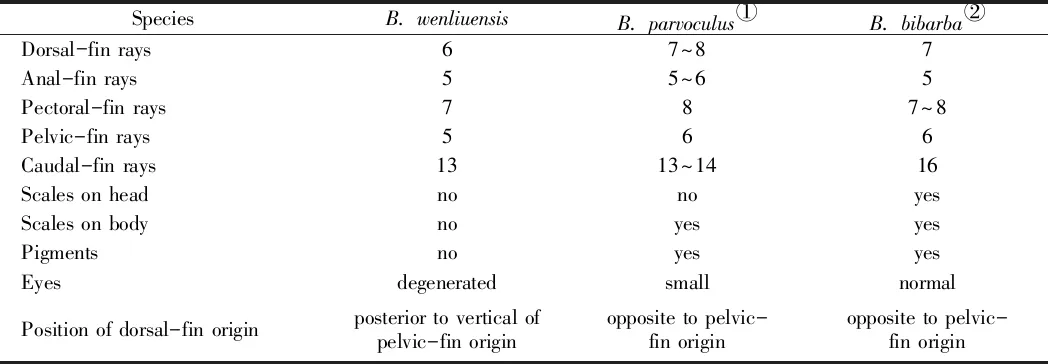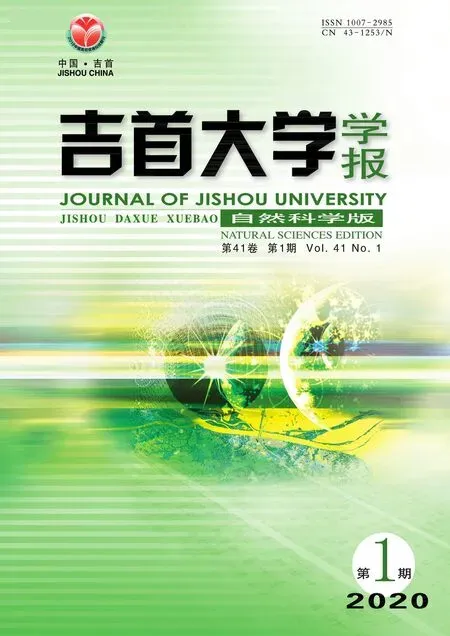A New Blind Subterranean Species of the Genus Bibarba from Yunnan, China*
2020-03-20YANGHongfuCHENZimingLIWeixian
YANG Hongfu, CHEN Ziming, LI Weixian
(1.School of Ecology and Environmental Science, Yunnan University, Kunming 650091, China; 2.Fisheries Administration of Qiubei, Wenshan 663200, Yunnan China;3.Heilongtan Reservoir of Shilin, Kunming 652200, China)
Abstract:In October 2015,a new species of the family Cobitidae, Bibarba wenliuensis sp.nov., was discovered from underground water in Qiubei County, Yunnan Province, China.It can be distinguished from its two congeners by the following combination of characteristics: body with no pigments and no scales, head smaller, eyes degenerated completely, dorsal fin with 6 branched rays, dorsal fin origin posterior to vertical of pelvic-fin origin, caudal-peduncle length 25.0% of SL, shorter rostral barbels, longer maxillo-mandibular barbels, caudal peduncle with long and distinct dorsal and ventral crests.
Key words:Bibarba; cave fish; new species; Cobitidae
1 Introduction
The loach genusBibarbawas erected by Chen and Chen (2007), withBibarbabibarbaChen & Chen (2007) as the type species.The genusBibarbahas been diagnosed as possessing two pairs of barbels, suborbital spine relatively thick and short, bifid, and with a strong medio-lateral process, head without scales, body scales small, lateral line short, not exceeding the length of pectoral fins, caudal fin slightly emarginate, anus near anal fin, caudal peduncle with ventral adipose crest, males smaller than females, and with proportionally longer and thicker pectoral fins, and lamina circularis present in the third pectoral fin ray and not located on the base of fin (Chen and Chen, 2007).By now, two species,Bibarbabibarba(Chen & Chen 2007),Bibarbaparvoculus (Wu, Yang and Xiu 2015), belong to this newly erected genus.Bibarbabibarbawas found in the Chengjiang River, an upstream tributary of the Pearl River drainage in Du’an County, Guangxi, China,Bibarbaparvoculus was collected in Jicheng village, Tianhe Town, Luocheng County, Guangxi, China.All these two species were distributed in Guangxi, China.
In October 2015, one specimen of the genusBibarbawas collected, representing an undescribed species, from Huajiao Da Dong, a karst cave connected to subterranean waters in Huajiao Village (altitude: 1257 m), Wenliu Township, Qiubei County, Yunnan Province, China.We herein provide a description of the new species.
2 Materials and Methods
Specimen were collected with a cage net and were fixed in 10% formalin and then transferred to 75% ethanol for long-term storage.Fish were cataloged and stored in the collections of the Heilongtan Reservoir of Shilin County (2015102401).
Methods of counts and measurements followed Chu & Chen (1989) and Chen and Chen (2007), respectively.Measurements were taken point to point with digital calipers and data were recorded to 0.1 mm.Counts and measurements were made on the left side of the specimen.Subunits of the head are percentages of head length (HL).Head length itself and measurements of body parts are expressed as proportions of standard length (SL).The synchrotron radiation X-ray microtomography (SR-μCT) was performed at BL13W1 beamline of Shanghai Synchrotron Radiation Facility (SSRF).The suborbital spine was attached on the micropipette tip that was vertically mounted on the sample stage, and imaged by monochromatic synchrotron X-ray at the energy of 18.0 keV.The X-rays penetrating through the specimen were recorded as two-dimensional radiograph image (projection) by charge coupled device (CCD) X-ray camera PCO.2000 coupled with a 4X optical objective magnification system (PCO AG, Kelheim, Germany).The resulting spatial resolutions was 1.85 μm/pixel.Totally 720 projections, with 5 s of exposure time for each, were recorded during the specimen rotating over 180°.Flat field images and dark-field images were also collected during each acquisition procedure, in order to correct the electronic noise and variations in the X-ray source brightness.The data set were reconstructed into corresponding slices using the filtered back-projection algorithm (X-TRACT software, CSIRO).The three-dimensional rendering (3D rendering) was created from the stack of slices, manipulated and analyzed in the VG Studio Max (v2.1) software.
3 Results
Bibarbawenliuensissp.nov.(Fig.1)

Fig. 1 Bibarba Wenliuensis Sp. Nov. (2015102401, 57.7 mm SL) A: Lateral View; B: Ventral View; C: Radiograph of Lateral View
Holotype: 2015102401, 57.7 mm SL, 67.3 mm total length; Huajiao Da Dong, a karst cave connected to subterranean waters in Huajiao Village, 24°19′42.9″N; 104°25′17.6″E (altitude: 1 257 m), Wenliu Township, Qiubei County, Yunnan Province, China.
3.1 Diagnosis

Fig. 2 Head of Bibarba Wenliuensis Sp. Nov. (2015102401, 57.7 mm SL) A: Lateral View; B: Ventral View
This species can be distinguished from the other two congeners,B.bibarbaandB.parvoculus, by the following combination of characteristics: body with no pigments and no scales (vs.pigments on dosal side and scales on body inB.parvoculusand pigments along body and scales on head and body inB.bibarba); head smaller, head length 15.0% of SL (vs.18.3~20.4 in B.parvoculus and 20.4~22.7 inB.bibarba); eyes degenerated completely (vs.small eyes inB.parvoculusand normal eyes inB.bibarba); dorsal fin with 6 branched rays (vs.7~8 inB.parvoculusand 7 inB.bibarba); dorsal fin origin posterior to vertical of pelvic-fin origin (vs.opposite to pelvic-fin origin inB.parvoculusandB.bibarba); caudal-peduncle length 25.0% of SL (vs.19.9~22.2 inB.parvoculusand 14.1~19.6 inB.bibarba); shorter rostral barbels (5.4% HL vs.6.7~8.2 inB.parvoculusand 8.6~15.6 inB.bibarba); longer maxillo-mandibular barbels ( 21.5% HL vs.8.3~9.7 inB.parvoculusand 10.6~16.3 inB.bibarba); caudal peduncle with long and distinct dorsal and ventral crests (Fig.2,Table 1~2).

Table 1 Morphometric Characteristics of B. Wenliuensis(2015102401, 57.7 mm SL), B. Parvoculus and B. Bibarba
Notes: ① data are from Wu, Yang & Xiu (2015); ② data are from Chen & Chen (2007).
3.2 Description
Dorsal fin iii,6; anal fin ii, 5; pectoral fin i, 7; pelvic fin i, 5; caudal fin with 13 branched rays; 8 gill rakers on the outside of the first gill arch (Table 2).

Table 2 Counts and Partial Morphometric Characteristics Comparison
Notes: ① data are from Wu, Yang & Xiu (2015); ② data are from Chen & Chen (2007).
Proportional measurements ofBibarbawenliuensissp.nov.are shown in Table 1.Body is small and elongated; cylindrical anteriorly and compressed posteriorly; dorsal profile is slightly convex and ventral profile slightly concave.Snout is rounded, nostrils close together, nearer to anterior edge of eye than to snout; anterior nares in short tube.Eyes are degenerated completely with vestige on upper part at middle of head.Suborbital spine is present, slender, located anterior to eye vestige; spine is bifid and with a medio-lateral process (Fig.3).Mouth is small, inferior, and arched, with a triangle opening.Lips are fleshy; upper lip arched and connected with lower lip; lower lip developed with a longitudinal mental groove at the middle of lower lip, each side of lower lip with a developed fleshy mental lobe.There are two pairs of small barbels; rostral barbels are shorter than maxillo-mandibular barbels; maxillo-mandibular barbels are connected with lower lip; tip of maxillo-mandibular barbels almost reach vertical of the anterior edge of eye vestige.

Fig.3 Left Suborbital Spine of Bibarba Wenliuensis Sp.Nov.(2015102401, 57.7 mm SL)A: Dorsal View; B: Ventral View; C: Left Lateral View and D: Right Lateral View
Dorsal-fin origin is near midpoint of body, closer to caudal-fin base than to snout tip; dorsal fin length is shorter than head length; profile of dorsal fin is truncate.Pectoral fin is 13.3% SL.Pelvic fin is short, 9.5% SL, its origin anterior to dorsal fin origin; depressed pelvic fin does not reaching anus.Anus is situated anterior to anal fin.Anal fin is small, its origin nearer to pelvic-fin origin than to caudal fin base.Caudal peduncle is long, with distinct dorsal and ventral crests.Caudal fin is emarginate, tips slightly pointed.
Skin is smooth,no scales on the whole body.Lateral line is not observed.
3.3 Color Pattern
Live coloration ofBibarbawenliuensisis whitish and semi-transparent; fins are transparent, without pigment.After fixed in 10% formalin, body becomes yellowish, and fins become whitish.
3.4 Habitat Description

Fig.4 Habitat of Bibarba Wenliuensis Sp.Nov.A Dry Cave Through Which the Seasonal Pool Connects with Subterranean Waters in Rainy Seasons
This species was collected from Huajiao Da Dong, a karst cave connected to subterranean waters in Huajiao Village, 24°19′42.9″ N; 104°25′17.6″ E (altitude: 1 257 m), Wenliu Township, Qiubei County, Yunnan Province, China with water temperature at 22 ℃, at 14:00 pm, Oct., 24, 2015.This region is famous for its well-developed karst landforms, as well as seasonal and subterranean rivers.These special geological conditions might provide very limited habitat for each species in this area (Fig.4).
3.5 Distribution
So far, this species is known only from the type locality.This seasonal pond is connected with subterranean waters belonging to the Qingshuijiang River basin (a tributary of the Nanpangjiang River, upper reaches of the Pearl River).
3.6 Etymology
The specific name,wenliuensis, is refered to the Wenliu Township, the sampling site.
4 Discussion
In the southwest of China, the karst limestone caves are very developed, forming the upper reach of Pear River which flows through this region (include Yunnan, Guizhou and Guangxi), and the river form is anfractuous.Seasonal rivers, seasonal pools, cave rivers, subterranean rivers, and streamlet between mountains are commonly presented in the flowing courses of Pear River.The complicated geological environments may provide obstacles for fish group to go far beyond their habitat and conditions for allopatric speciation.Correspondingly, many species described from this region show the special spot-like distribution, which is different from that of some other species that can occur in an extensive range in a normal river.
All the 3 species ofBibarba, namely,B.bibarba,B.parvoculusandB.wenliuensisare occurring in the same river basin, Pear River.B.bibarbais surface species with normal eyes and pigments on body,B.parvoculusandB.wenliuensisare troglobitic species with more or less reduction of eyes and pigmentation.B.wenliuensisis the first species of the genus with eyes degenerated completely and no pigments, this may be a result of much longer time of adaptation in the dark subterranean waters (Fig.5).

Fig.5 A: Bibarba Wenliuensis Sp.Nov.(2015102401, 57.7 mm SL); B: B.Parvoculus (2010110587, 48.3 mm SL)
Acknowledgments:We thank Mr.Jiahu Lan for providing the comparing specimen ofB.parvoculus.We are grateful to Dr.You He, Shanghai Institute of Applied Physics, Chinese Academy of Sciences, for providing radiograph of specimen and 3D rendering of suboribital spine.
